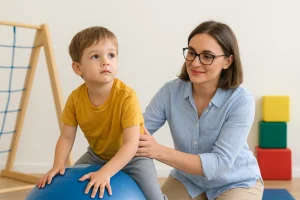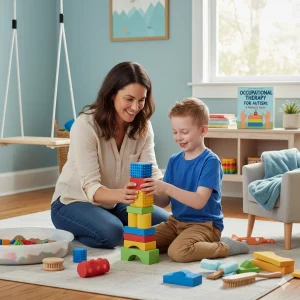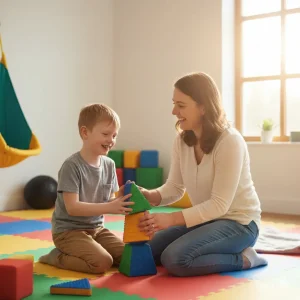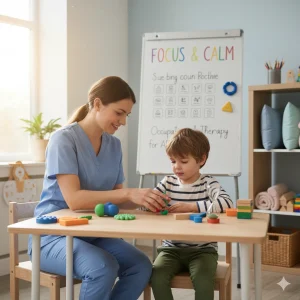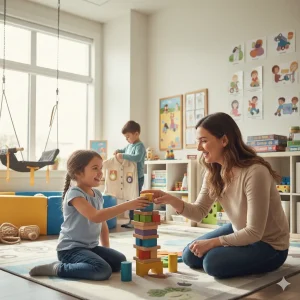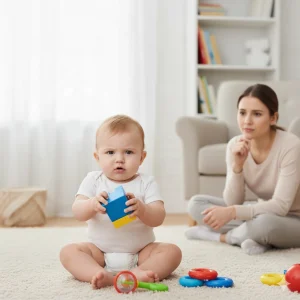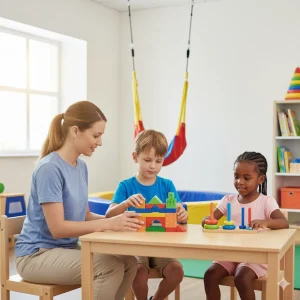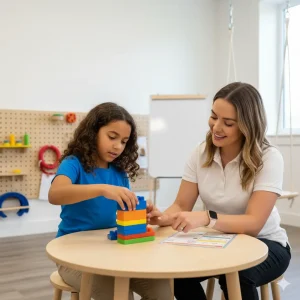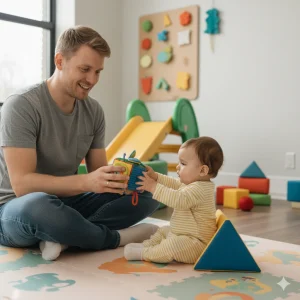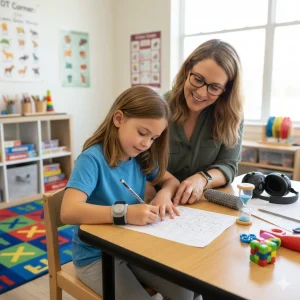Improve Your Child’s Eye Contact With Occupational Therapy
By Wellness Hub
Last Updated: October 30, 2025
Eye contact is one of the earliest and strongest forms of human connection. When your child looks into your eyes, it’s not just a glance — it’s a sign of attention, understanding, and trust. For many parents, however, getting their child to make eye contact can be a daily struggle, especially if the child is shy, has autism, or faces sensory challenges. This is where occupational therapy to improve eye contact can make a real difference — helping children connect better, engage meaningfully, and build stronger social and communication skills through guided, play-based sessions.
The good news? Occupational Therapy (OT) offers proven, play-based methods to help children develop this important social skill — gently, naturally, and joyfully.
Why Eye Contact Matters for Child Development
Eye contact is more than politeness — it’s the foundation of social communication. From birth, babies seek faces, learn emotions through gaze, and respond when someone looks at them.
The importance of eye contact:
- Builds attention and focus — the child learns to tune in to people.
- Encourages bonding and connection with parents and peers.
- Supports language learning — seeing lips and facial expressions improves speech understanding.
- Helps social awareness — the child reads emotions and reacts appropriately.
According to the CDC, lack of eye contact after 12–18 months may indicate social-communication delays. Early awareness and intervention make a big difference.
Also Read: What to Do If Your Toddler Struggles With Eye Contact and Speech
What Causes Poor Eye Contact in Children?
Not all children who avoid eye contact have autism. There are many possible reasons.
Common causes include:
- Autism Spectrum Disorder (ASD): Children may struggle with social cues or feel overwhelmed by direct gaze.
- Sensory Processing Differences: Some children find eye contact overstimulating or uncomfortable.
- Shyness or Social Anxiety: They may feel nervous around strangers or new settings.
- Attention or Vision Issues: Trouble focusing or maintaining visual attention.
- Delayed Imitation Skills: Difficulty copying facial expressions or actions reduces interaction.
A trained occupational therapist can identify which of these factors play a role and design activities to improve eye contact step by step.
How Occupational Therapy Helps Improve Eye Contact
Occupational therapy focuses on helping children engage better with their environment — physically, emotionally, and socially. For eye contact, OTs work through play-based sensory experiences that teach attention, confidence, and emotional regulation.
How OT makes a difference:
- Sensory Integration: OT helps children process sounds, sights, and touch better so they can stay calm and focus on faces.
- Joint Attention Games: Activities like passing a ball or blowing bubbles promote shared attention between child and adult.
- Visual Tracking: Exercises improve the child’s ability to follow movement, building gaze control.
- Social Play: Play routines teach children to look, wait, respond, and take turns naturally.
- Gradual Desensitisation: Therapists reduce anxiety related to eye contact through gentle exposure and encouragement.
AOTA (American Occupational Therapy Association) notes that structured play and sensory regulation are key components for improving gaze and engagement in children with autism.
Common OT Techniques for Better Eye Contact
Therapists use creative methods that don’t pressure children but make looking into eyes part of fun interactions.
- Mirror Play: Sit together and make funny faces or sing songs while watching in the mirror.
- Bubble Play: Blow bubbles and wait for your child to look at you before you blow the next one.
- Ball Games: Roll or toss a ball back and forth to build shared attention.
- Peek-a-Boo Variations: Classic but powerful for younger children.
- Imitation Games: Copy your child’s movements or expressions to encourage mutual engagement.
Each activity targets joint attention, visual focus, and social motivation — the three building blocks of eye contact.
Home Activities to Support Eye Contact
Parents play a huge role in strengthening eye contact every day. You don’t need fancy materials — just mindful, playful moments.
Simple home ideas:
- Face-level interaction: Sit or kneel so your eyes are at the child’s level.
- Use favourite toys: Hold the toy near your eyes when you talk to your child.
- Sing and pause: Sing a line of a rhyme, stop, and wait for your child to look at you to continue.
- Celebrate small looks: Smile, clap, or gently praise every attempt at eye contact.
- Keep it short: A few seconds of meaningful gaze is better than forcing long eye contact.
Tip: Daily play for even 10–15 minutes can create noticeable progress within a few weeks.
The Role of Sensory Processing in Eye Contact
Many children who avoid eye contact also struggle with sensory overload — lights, sounds, or movements may distract or distress them.
Occupational therapy uses sensory integration techniques to help children feel safe and organised. Examples include:
- Deep pressure activities (hugs, weighted blanket).
- Swinging or rocking for balance.
- Tactile play (sand, water, clay).
Once a child’s body feels calm, they are more likely to connect visually and emotionally.
When to Seek Professional Help
You should consider seeing an occupational therapist if your child:
- Rarely looks at faces even by 18 months.
- Avoids eye contact consistently in play or conversation.
- Shows speech or social delays alongside poor eye contact.
- Gets easily overwhelmed in noisy or bright settings.
Early evaluation allows for targeted therapy and quicker progress. According to the World Health Organization (WHO), early intervention improves long-term communication outcomes in children with developmental differences.
How to Find the Right Occupational Therapist
Choosing the right therapist ensures effective, child-friendly support.
What to look for:
- Specialisation in pediatric occupational therapy.
- Experience with autism and sensory processing.
- Gentle, play-based approach (not forceful eye-contact training).
- Comfort and trust between therapist, parent, and child.
If you’re based in India, search for “occupational therapy near me” or specific local terms such as “occupational therapy Hyderabad” to find trusted centres like Wellness Hub.
How Long Does It Take to See Results?
- Every child progresses differently. Some may begin responding after a few sessions; others may take months of consistent work.
- The key is consistency, patience, and emotional safety — not speed.
- Therapists often combine OT, speech therapy, and play therapy for holistic improvement.
At-Home + Professional Support = Best Results
While professional sessions are vital, parents’ daily involvement matters the most. Combine therapy guidance with at-home play routines for steady progress.
Examples:
- Follow therapist-recommended play ideas on alternate days.
- Use your child’s comfort toys during interaction time.
- Practice eye contact during daily activities — meals, songs, or bedtime stories.
Conclusion
Helping your child make better eye contact starts with love, patience, and the right guidance. Occupational therapy uses fun, play-based activities to build focus, confidence, and social connection. With regular practice at home and support from a therapist, your child can start enjoying eye contact naturally. Remember, every small glance and shared smile is progress. Early therapy makes a big difference in your child’s growth and communication.
Frequently Asked Questions:
1. How does occupational therapy improve eye contact?
Occupational therapy helps children feel calm, focused, and comfortable while interacting. Through fun games, sensory activities, and visual-motor play, therapists gently encourage children to look, respond, and connect naturally during play and daily routines.
2. Is poor eye contact always a sign of autism?
No, not always. Some children avoid eye contact due to shyness, sensory overload, or delayed attention — not necessarily autism. Occupational therapy helps find out why it’s happening and supports each child’s specific needs.
3. Can parents help at home?
Definitely! Parents can play a big role. Simple games like mirror play, peek-a-boo, and face-to-face singing make learning eye contact fun and stress-free. Just a few minutes a day can make a big difference.
4. How soon should I start therapy?
Start early if your child often avoids looking at people’s faces, especially after 18 months of age. The earlier you begin, the easier it is to build social skills through gentle, guided practice.
5. Does OT also help with speech?
Yes! Eye contact and speech go hand in hand. When a child learns to look, listen, and respond, their communication skills improve naturally. Many therapists combine speech and occupational therapy for better results.
6. How long does it take to see progress?
Every child learns at their own pace. Some may respond within a few weeks, while others need more time. With regular sessions and home support, steady progress is almost always visible within a few months.
7. Can sensory issues cause poor eye contact?
Yes. Bright lights, loud sounds, or touch sensitivity can make eye contact uncomfortable. Occupational therapists help children manage sensory input so they can stay relaxed and make eye contact easily.
8. Are online OT sessions effective?
Yes, online sessions can work well when parents are involved. Therapists guide you through structured play and daily routines to help your child practise eye contact and attention safely from home.
9. What age is ideal for starting OT?
Occupational therapy can begin as early as 18 months, especially if you notice delays in social interaction or communication. Early support helps children catch up faster and build confidence.
10. Where can I find good OT centres in Hyderabad?
You can visit Wellness Hub, a trusted therapy centre offering expert occupational, speech, and behavioural therapy in Hyderabad. Their team provides both in-person and online therapy for children aged 2–8.
About Author:
Sonali Sharma, Occupational Therapist
Sonali Sharma is a skilled Occupational Therapist at Wellness Hub, with over three years of experience in supporting children with developmental, behavioral, and learning challenges. She holds a Bachelor’s in Occupational Therapy (BOT) from Amity University and has worked with leading institutions such as NIMHANS Bengaluru and ESIC Hospital Faridabad.
At Wellness Hub, Sonali provides online occupational therapy sessions tailored to each child’s needs. She specializes in pediatric therapy, autism support, sensory integration, and developmental skill-building, helping children strengthen motor skills, improve focus, and become more independent in daily life.
Her therapy style is child-centered, play-based, and evidence-driven—making sessions both effective and enjoyable for kids. Sonali also equips parents with practical home therapy strategies to extend progress beyond sessions.
Passionate about empowering families, Sonali believes in creating a nurturing space where children can thrive while parents feel supported every step of the way.
Book your Free Consultation Today
Parent/Caregiver Info:
Client’s Details:
* Error Message
